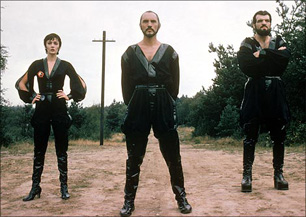Chapter Two: Superman II
By Brett Ballard-Beach
January 3, 2013
The best parallel I can think of is when directors hire non-professionals or non-actors for roles because that person is the embodiment of who they are looking for in the character. Reeve is Superman and Clark Kent. He gives both characters the same calm temperament, warm personality, and inner goodness. Flying Lois around the world, nabbing bank robbers, re-directing a wayward nuclear missile, he makes being a superhero look easy, and decent, and fun. Superman was an enormous success, grossing nearly $200 million.
What happened, then, on the road to series implosion? There was the incalculably insane what-the fuckness of inserting Pryor into the mix in Superman III. (The poster art for the film perfectly captures this, as well as the film’s shift to goofy comic shenanigans, with a terrified Pryor being cradled in Superman’s arms as the latter flies up and away from the villain’s lair.) Reviews were dreadful and the installment grossed one-third the amount of the first film and half of the second film. When The Quest for Peace rolled around five years later, it was on a budget of only $19 million (about one-fifth of the combined budget for the first two films) and it couldn’t even recoup that, grossing a paltry $15 million.
The connecting link in all of this is Superman II, which also received overwhelming critical kudos and passed the $100 million mark domestically. This was despite a troubled production borne out of the fact that producers Alexander and Ilya Salkind chose to film the first two films back to back, as they had earlier in the decade with The Three Musketeers and The Four Musketeers. While normally this is a great cost-saving measure, budget overruns and clashes with Richard Donner led to his being sacked after a great portion of Superman II had already been filmed. The Salkinds brought in Richard Lester (their director on both Musketeers films as well as helmer of the Beatles’ films A Hard Day’s Night and Help!) who ended up reshooting scenes and shooting a host of new scenes, such that the final mix was said to be about 75/30 his work. He got sole credit.
Nearly 30 years later, with the reboot attempt Superman Returns (a film that for better and worse attempts to continue Donner’s vision while ignoring parts III and IV) slated to hit theaters, in Summer 2006, the Suits that Be decreed that a reissue of the series was in order. And with several decades of built-up interest and outcry from fans for some official document of Donner’s original vision, he was allowed to consult and advise on just such a project. All available footage that he had shot was used and scenes filmed by Lester were inserted only where the gaps in continuity and storyline would have been too noticeable. This ratio was fairly similar to Lester’s version, with an 80/20 split, this time in Donner’s favor.
Having laid all that out, what I find the most intriguing about viewing the two IIs in such close conjunction is how similar they are in small ways but how different they are in the big picture. In sum, Lester’s version feels like a Chapter Two, warts and all, encapsulating the first film in six minutes to bring the audience up to speed (with one glaring omission) and then settling in for two uninterrupted hours of Lois and Clark banter (and Lois and Superman nookie), and extended destruction and mayhem. Donner’s version is more like an appendix to the first film, in that it ties in even more closely to the events of the first film (the three villains are freed from their interdimensional floating prison by a nuclear blast from the wayward missile that Superman launched into outer space). And this is perhaps as it should be, since filming was done at the same time with the intention of making one epic story broken into two parts.
Continued:
1
2
3
4
5
|
|
|
|




